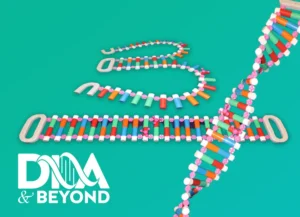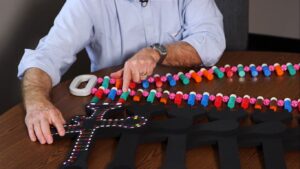#1 Did you know…
that like mRNA, tRNA is transcribed and processed in the nucleus and then exported to the cytoplasm to do its job? Transfer RNA’s structure is single stranded but develops a secondary and tertiary structure. RNA primary structure consists of the nucleotide sequence (75 to 95 units long) that makes up the one-dimensional, linear tRNA molecule. The secondary structure consists of the base pairing within the single stranded RNA as complementary nucleotides from within an RNA strand can base-pair with complementary parts of itself, giving a two dimensional, cloverleaf structural formation to the tRNA molecule. Within this two-dimensional structure, double-stranded stems and single-stranded loops create the multiple regions of the tRNA, each with a different function.
#2 Did you know…
that the biochemistry of the acceptor arm and the three loops of a tRNA are quite sophisticated in design?
The acceptor arm (or amino acid arm) contains a single-stranded cytosine-cytosine-adenine (CCA) 3’ end where an amino acid can be covalently bonded to the hydroxyl group of the terminal adenine. Identity elements (also known as identity determinants or recognition points) found throughout the tRNA molecule, especially areas of the acceptor region and anticodon region help makes the tRNA recognizable by specific enzyme called aminoacyl-tRNA synthetases (or simply, tRNA ligases) that will attach a specific amino acid to the 3’ adenine through a process called aminoacylation or “charging.”
There are 20 main amino acids and thus, there are 20 different ligases, one for each amino acid. (Ligases are enzymes that specialize in knitting together the molecular building blocks of DNA and RNA.) Each synthetase will only recognize a particular set of tRNAs that correspond to a specific amino acid and thus the ligase is based on its identity elements.
The anticodon arm contains a three-nucleotide sequence called the anticodon which is recognizable by complementary sequences on mRNA called codons and assists in protein formation by specifying the amino acid that corresponds to a particular codon. The TΨC-arm (named so because it contains thymidine, a uridine isomer called pseudouridine, and cytidine) helps in the formation of the 3-D or tertiary structure of tRNA and being thought to be recognized by ribosomes. The DHU-arm (named it contains a modified uridine called dihydrouridine) also helps tertiary structure formation as well as being thought to contain identity elements. Finally, the variable loop can be absent or present in different tRNA and helps in tertiary structure formation and stabilization.
Molecular kissing inside the tertiary form: Specifically, the DHU loop and the TΨC loops complementary base-pair with each other in a process known as kissing hairpins (as the hairpin loops “kiss each other” through hydrogen bonds) to help create the twisted L-shaped tertiary structure of the tRNA.
#3 Did you know…
that attaching the correct amino acid to the correct tRNA is an amazing process? Here is a sketch of the biochemistry: An individual amino acid (of 20 different amino acids total) together with an adenosine triphosphate (ATP) binds to its corresponding aminoacyl tRNA-synthetase enzyme (of 20 different synthetases total) to form a complex consisting of the synthetase and aminoacyl- adenylate monophosphate (aminoacyl-AMP) called an adenylate aminoacyl-tRNA synthetase complex (or adenylate-aaRS complex). ATP is a high-energy nucleic acid that acts as the central energy source in cells. As its name suggests, it is an adenosine nucleoside with three phosphate groups (instead of the one we are usually used to in nucleotides) and releases energy through breaking off one or more of its phosphate groups. This energy can then be used (often by enzymes) to facilitate biochemical reactions and, in this case, it is facilitating the first step in the eventual transfer of an amino acid to a tRNA by giving the synthetase the energy it needs to bind to the amino acid.
In this specific reaction, tRNA-synthetase breaks two phosphate groups off of ATP to release inorganic pyrophosphate (PP i ; made from the two phosphate groups), adenosine monophosphate (AMP), and energy. The energy is then used to assist the synthetase in facilitating the binding of AMP to the amino acid to make aminoacyl- AMP within the synthetase and an overall complex consisting of the synthetase and the aminoacyl-AMP. The complex then recognizes a tRNA molecule. Several tRNA molecules can be recognized by a single complex. After recognizing a tRNA molecule, the complex catalyzes the transfer of the aminoacyl group to the tRNA to form an aminoacylated-tRNA and hence, the name “aminoacyl-tRNA synthetase.”
The tRNA contains anticodons that can recognize more than one codon as when the tRNA binds to an mRNA codon, the base pairing between the third nucleotide position in the codon can be a mismatched, or “wobble” base-pair as it is less stable than Watson-Crick base-pairing. The fact that a single aminoacyl tRNA-synthetase complex can recognize multiple tRNA and that multiple codons can be recognized by a single anticodon means that, even though we have 64 different codons (only 61 of which code for different proteins), we don’t need to have 61 different anticodons or 61 different tRNA. In fact, while different species have different numbers of tRNA, most cells have at least 31 to a maximum of 41 tRNA to code for all the codon possibilities.
#4 Did you know…
how long the two rRNA segments are? According to one source– https://www.news-medical.net/life-sciences/-Types-of-RNA-mRNA-rRNA-and-tRNA.aspx – “rRNAs are found in the ribosomes and account for 80% of the total RNA present in the cell. Ribosomes are composed of a large subunit called the 50S and a small subunit called the 30S, each of which is made up of its own specific rRNA molecules. Different rRNAs present in the ribosomes include small rRNAs and large rRNAs, which belong to the small and large subunits of the ribosome, respectively.” Then, the article adds, “In bacteria, the small and large rRNAs contain about 1500 and 3000 nucleotides, respectively, whereas in humans, they have about 1800 and 5000 nucleotides, respectively. However, the structure and function of ribosomes is largely similar across all species.”
Also, did you know that the tunnel that runs through the ribosome factory has three “binding sites” where key actions take place? Ribosomes, in fact, contain three main binding sites: an aminoacyl (A), peptidyl (P), and exit (E) site. The aminoacyl site binds to an aminoacylated- tRNA (or an aminoacyl-tRNA), the peptidyl site contains a tRNA bound to a growing peptide, and the exit side contains a tRNA that is no longer bound to an amino acid. In translation, the aminoacyl-tRNAs enter the A site–binding to a complementary codon on the mRNA, the ribosome catalyzes the transfer of the peptide or amino acid the on P site to the transfer RNA on the A site, and the mRNA shifts by a codon in a process called translocation–moving the tRNA in the former A site to a new P site, the tRNA in the former P-site to the exit site for discharge, and having a free A site to allow a new tRNA to arrive.
Image credit: By Boumphreyfr vector conversion by Glrx – File:Peptide syn.png, CC BY-SA 3.0,


